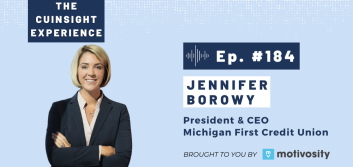Life is uncertain: Protect what you have
A compliant overdraft program can increase confidence in an uncertain world

When it comes to maintaining financial stability these days, a great deal of uncertainty comes into play. For financial institutions, on-going regulation on existing non-interest income sources, a lack of new revenue stream opportunities, as well as increased competition from non-traditional financial service providers can paralyze a credit union’s performance if steps aren’t taken to find reliable earnings solutions.
For your members, any number of unexpected situations can create a ripple effect that puts a heavy burden on a tight budget for extended periods of time—like forgetting to record the amount of an unusual purchase. Or, a health crisis or fender bender that results in medical bills, costly auto repairs and potential increased insurance premiums that can be difficult to afford when there is no emergency fund. According to a Bankrate survey, just four out of 10 Americans have savings they could rely on to cover an emergency expense—while three out of five had experienced a major unexpected expense last year.
In both situations, relying on the status quo to ride out uncertain times typically leads to unfavorable results—continued low performance for your credit union, and your members dealing with unexpected situations and financial obligations.
Compliant overdraft solution adds certainty across the board
One proven strategy that addresses the financial uncertainty for both credit unions and their members is a fully disclosed overdraft program. Implementing a program for the first time—or updating an existing one that has become stagnant—provides a reliable source of non-interest income to help achieve performance goals and more. At the same time, a discretionary overdraft program extends a safety net to help account holders address temporary financial shortfalls and can help them avoid additional fees when used correctly.
And when administered by the following guidelines, credit unions can rest assured that their program meets all regulatory expectations and best practices:
- Provide all the details up front. Sharing the information will help avoid any confusion among members about how the program works. Plus, they will be able to more easily understand the service and benefits, as well as how to use it responsibly. The bigger payoff is that members will also see it as a valuable service should they find themselves facing an unexpected expense or temporary financial shortfall.
- Stay on top of communication. Strategic and effective communication with members alleviates compliance issues it goes a long way in terms of service. On-going communication provides members with more clarity about what the credit union has available to offer should they have a need. As a result, members will be more inclined to consider the credit union a valuable resource when they need other financial services or trusted advice.
- Keep staff training in focus. Ensuring everyone understands the program internally and conveys the information to members with consistency and confidence is a must. Multiple branches or even employee turnover can present challenges which may lead to missteps in having everyone speak from the same page when explaining products and services. In a recent case, an account holder complaint about receiving inconsistent information about overdraft services from staff members seated in close proximity to each other led to increased examiner scrutiny. The financial institution was ordered to refund overdraft fees because it wasn’t providing all account holders with the same information about its program.
- Monitor program results regularly. Make sure a solid process for consistently overseeing the program is in place—including key data points and tracking documentation. It’s not likely to have the responsibilities tied to the credit union’s loan portfolio to staff members in different locations with multiple duties and operational focus. Likewise, the credit union’s overdraft program represents an important revenue source and beneficial service option that should be maintained with consistency and focus to achieve optimal results.
Address the unknown with certainty
As credit unions remain on the lookout for potential revenue sources, regulators have continued to state that “there are currently no new regulatory amendments or specific timing for when a rule may be proposed on overdraft programs.” But it is important not to take a “wait and see” attitude while your members continue to face economic challenges of their own.
A fully disclosed overdraft program—one that is based on the latest regulatory guidelines and best practices—can help to protect your revenue and erase your regulatory uncertainty. At the same time, it can put your account holders’ minds at ease when it comes to protecting themselves against unexpected expenses and multiple fees when they make an error on their account. From a service standpoint, that kind of certainty creates a positive consumer experience that leads to loyal, long-time member relationships.





